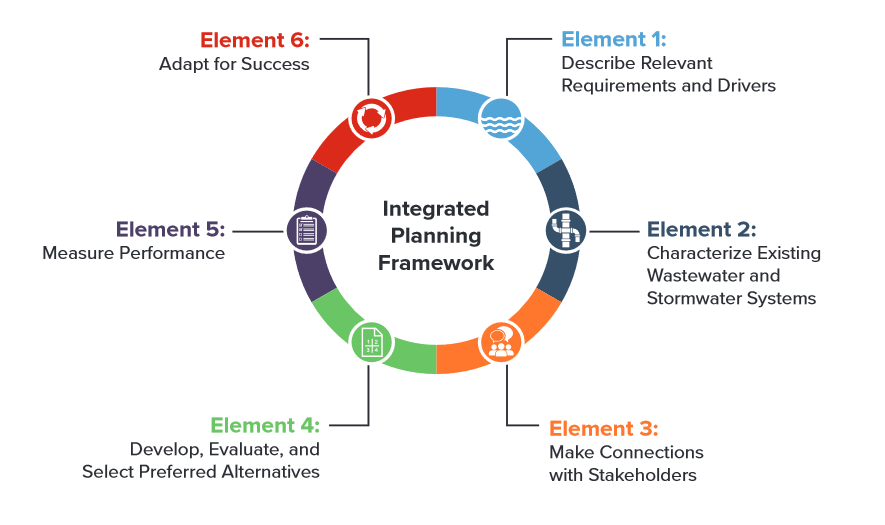
Post by Evan Kirk, Project Director at the UNC EFC
The EFC has been partnered with the US EPA since August 2021 to develop resources and lead workshops designed to assist municipalities and state permitting authorities in getting started with integrated planning. All EFC integrated resources are available on the Integrated Planning for Municipal Stormwater and Wastewater webpage. EPA has also developed numerous resources available on their Integrated Planning for Municipal Stormwater and Wastewater webpage.
The availability of so many integrated planning resources can be a huge asset for municipalities as they get started with the integrated planning process. However, sifting through the resources to answer specific questions can be overwhelming. Below is a list of commonly asked questions that UNC EFC has encountered regarding integrated planning in the past two years. The answers to the questions and the linked resources may assist in answering similar questions in your community.
What is integrated planning?
EPA’s Integrated Municipal Stormwater and Wastewater Planning Approach (Integrated Planning) is a process to identify efficiencies in wastewater and stormwater programs to best prioritize capital investments. It was designed to help municipalities address multiple Clean Water Act requirements and sequence investments to address its most serious water quality issues first. The EPA has developed a helpful fact sheet that highlights the basics of integrated planning, including six essential elements (see image at the top of the page).
Are there examples of communities that have successfully implemented an integrated plan to meet community goals?
One of the most effective ways for municipal staff to earn buy-in from stakeholders and elected officials to complete an integrated plan is to show them the success stories of similar municipalities. There are dozens of municipalities across the country that have used integrated planning to achieve positive clean water and community outcomes. Their success stories can be inspiring for those just getting started.
The UNC EFC interviewed four municipalities that successfully leveraged integrated plans to achieve climate resilience and environmental justice outcomes. The findings of these interviews are summarized in a report, Leveraging the Integrated Planning Framework for Advancing Climate Resilience and Environmental Justice.
EPA completed 13 community profiles that showcase water quality challenges, integrated planning priorities, infrastructure investments, and preliminary results across different municipalities. These results were reported to Congress as an action item of the 2019 Water Infrastructure Improvement Act.
How does a community get started with the integrated planning process?
Knowing the next step to take to get started with integrated planning can be a hurdle for communities. Municipalities that have successfully completed integrated plans provide helpful examples to follow and learn from
The UNC EFC hosted a virtual workshop in April 2022 to identify common barriers to getting started with integrated planning and help communities overcome those barriers. A recording of the workshop is available to view on the UNC EFC event page.
Following the April 2022 virtual workshop, EFC published a blog summarizing the four most important takeaways on how a municipality can get started with integrated planning:
- Get informed.
- Plan ahead.
- Define the plan’s scope through stakeholder engagement
- Think about funding early
What funding is available for developing an integrated plan?
While the efficiencies identified within the integrated planning process can result in a lower long-term cost of compliance for a community, funding the planning process can be a challenge. Luckily there are a variety of potential funding sources and strategies to pay for the planning process including creative in-house funding, grants, and loans.
The EPA has developed a fact sheet highlighting some of these funding sources for developing an integrated plan.
The EPA is also offering technical assistance to communities and state permitting authorities after September 30, 2022.
Need technical assistance? The UNC Environmental Finance Center is here to help!
The Environmental Finance Center at UNC-CH offers free one-on-one technical assistance for small water systems. If you have an interest in our support, fill out our interest form here or contact mullins@sog.unc.edu.
Visit https://efc.sog.unc.edu/technical-assistance/ to read more about technical assistance.


One Response to “Integrated Planning Resources 101”
John Stephens
FYI – perhaps a bit of a stretch per the topic, but Integrating Land Use and Water Management, Lincoln Institute of Land Policy: https://www.lincolninst.edu/publications/policy-briefs/integrating-land-use-water-management
Land without water cannot support urban form of any scale, yet many land use decisions are made without regard to water, and vice versa. This Policy Brief introduces readers to best management practices that enable local governments and water providers to integrate the two systems. Supported by case studies from several U.S. communities, the brief demonstrates that planning is a crucial step for land and water integration. This Policy Brief is a condensed version of Integrating Land Use and Water Management, a Policy Focus Report by Erin Rugland that has been described as “relevant, informative, and necessary at this moment in time.”